(完整版)2018年最新初中英语教资考试教学设计题模板
2018年教师资格证初中英语面试真题及解析
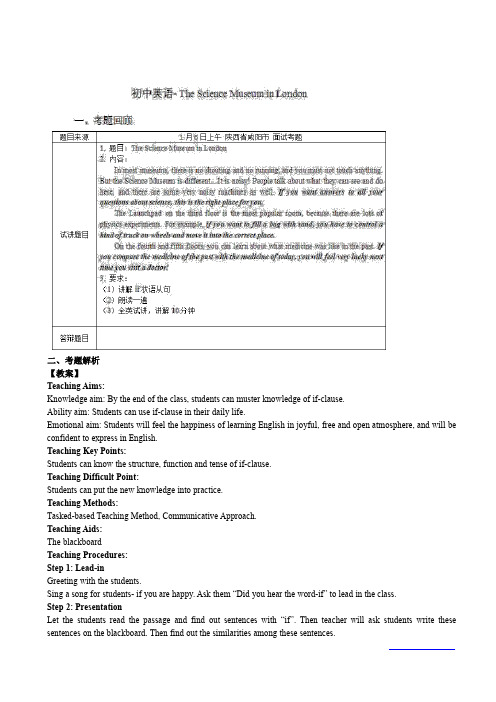
二、考题解析【教案】Teaching Aims:Knowledge aim:By the end of the class,students can muster knowledge of if-clause.Ability aim:Students can use if-clause in their daily life.Emotional aim:Students will feel the happiness of learning English in joyful,free and open atmosphere,and will be confident to express in English.Teaching Key Points:Students can know the structure,function and tense of if-clause.Teaching Difficult Point:Students can put the new knowledge into practice.Teaching Methods:Tasked-based Teaching Method,Communicative Approach.Teaching Aids:The blackboardTeaching Procedures:Step1:Lead-inGreeting with the students.Sing a song for students-if you are happy.Ask them“Did you hear the word-if”to lead in the class.Step2:PresentationLet the students read the passage and find out sentences with“if”.Then teacher will ask students write thesesentences on the blackboard.Then find out the similarities among these sentences.According to the answers from students,teacher make a brief summary:1.If-clause means condition and the main clause is the result.2.The main clause and if-clause have the same tense.However,if it describes things in the future,the main clause uses the Simple Future Tense and if-clause use the Simple Present Tense.Step3:PracticeRead the sentences by themselves and practice with neighbors.Step4:ProductionUse the sentence and structure what we learned today to make a conversation with your neighbor and invite some students performance it.Step5:Summary and homeworkSummary:Sum up what we have learned today.Homework:After class,teach these sentences to their parents.Blackboard Design:二、考题解析【教案】Teaching AimsKnowledge aim:Students can understand this short passage and master some expressions about comparative degree.Ability aim:Students will improve their reading efficiency and reading ability.Emotional aim:Students are willing to read a lot of English reading materials in their daily life.Teaching Key&Difficult Points:Key point:Students can understand comparative degree.Difficult point:foster good habit of reading English materials in their daily life.Teaching procedures:Step1:Warming upShow two pictures of twins,encourage students to describe them in their own words and then share their answer with each other.Step2:PresentationRead the short passage for the first time and they need to read it as fast as the can,ask them what is the main idea of this passage and students share answers.Students read the passage for the second time and ask them some more questions and ask them to pay attention tothe comparative degree.Step3:PracticeGive students some adjective or adverbial words,and ask them to write down the comparative form of these words, the one who writes most without mistakes will get a present.Step4:ProductionStudents work in groups to describe a person with comparative degree,teacher will give them8minutes to prepare it and8minutes later,invite some students to be the story teller to introduce his or her friends.Step5:Summary&HomeworkStudents look at the blackboard and retell the short passage to summarize this class,and the homework is that students introduce Jenny and Nancy to their friends or parents.Blackboard design:二、考题解析【教案】Teaching aims:Knowledge aim:Students will master the expression of date and the sentence structure:-What is...’s birthday?-It is...Ability aim:Students will improve their abilities of speaking and listening.Emotional aim:Students will be more confident in speaking English.Key and difficult point:Key Point:Students will master how to express a date in English.Difficult Point:Students will use the sentence structure in daily life.Teaching procedure:Step1:Warming-up1.Greetings.2.Ask students if today is anyone’s birthday.And invite the whole class to sing a‘Happy Birthday’song to him or her.Step2:Pre-listening1.Review the knowledge about ordinal numeral:write some numbers on the blackboard and ask students to change the cardinal numeral into ordinal numeral.2.Ask students to look at the picture in the textbook to predict what the dialogue may be about.Step3:While-listening。
2018年下半年中学教师资格认定考试(初级英语学科知识与教学能力)真题及标准答案
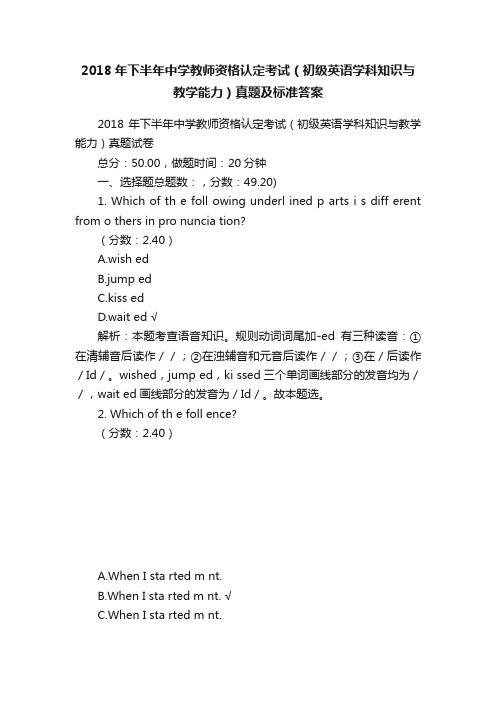
2018年下半年中学教师资格认定考试(初级英语学科知识与教学能力)真题及标准答案2018年下半年中学教师资格认定考试(初级英语学科知识与教学能力)真题试卷总分:50.00,做题时间:20分钟一、选择题总题数:,分数:49.20)1. Which of th e foll owing underl ined p arts i s diff erent from o thers in pro nuncia tion?(分数:2.40)A.wish edB.jump edC.kiss edD.wait ed √解析:本题考查语音知识。
规则动词词尾加-ed有三种读音:①在清辅音后读作//;②在浊辅音和元音后读作//;③在/后读作/Id/。
wished,jump ed,ki ssed三个单词画线部分的发音均为//,wait ed画线部分的发音为/Id/。
故本题选。
2. Which of th e foll ence?(分数:2.40)A.When I sta rted m nt.B.When I sta rted m nt. √C.When I sta rted m nt.D.When I sta rted m nt.解析:本题考查语音知在后,主句结束时意思已经比较完整,则主句通常用降调,整个句子读完时也应该用降调;②若从句在前,主句在后,则语调通常是“前升后降”。
故本题选。
3. All t he______in t(分数:2.40)A.six-year-o lds √B.six-years-oldC.six-year-o ldD.six-years-olds解析:本题考查名词用法。
句意为“在这所学校里,所有六岁的学生都由同一个老师来教”。
分析句子成分可知,空格处应填名词形式。
si x-year-old相当于形容词;six-ye ar-old则为名词复数,表示同一类人。
故本题选。
4. The r isk of infec tion f or tha t pati ent ha sn't d iminis hed af ter th e oper ation.______, it h as inc reased.(分数:2.40)A.On t he who leB.On t he con trary√C.On t he ave rageD.On t he oth er han解析:本题考查介词短语辨析。
初中英语教资面试教案模板

初中英语教资面试教案模板一、教学目标:1. 知识目标:学生能够掌握面试中常用的英语表达方式和句型,提高英语口语表达能力。
2. 能力目标:学生能够运用所学的英语句型进行自我介绍、回答面试问题,并能够进行简单的英语对话。
3. 情感目标:培养学生对英语学习的兴趣和自信心,增强团队合作意识。
二、教学内容:1. 自我介绍:Good morning/afternoon/evening, my name is I am 16 years old. I e from I like I am interested in2. 回答面试问题:What is your favorite subject? Why? What do you like to do in your free time? How do you deal with difficulties?3. 英语对话:模拟面试场景,学生之间进行角色扮演,练习回答面试问题。
三、教学重点与难点:1. 重点:掌握面试中常用的英语表达方式和句型。
2. 难点:能够运用所学的英语句型进行自我介绍和回答面试问题。
四、教学方法与手段:1. 教学方法:任务型教学法、情景教学法、合作学习法。
2. 教学手段:多媒体课件、录音机、磁带、模拟面试场景。
五、教学过程:1. 热身活动(5分钟):播放英语歌曲,让学生放松心情,进入学习状态。
2. 课堂导入(10分钟):教师介绍面试的重要性,引导学生思考面试中需要用到的英语表达。
3. 知识讲解(15分钟):教师讲解面试中常用的英语表达方式和句型,并进行示范。
4. 实践环节(15分钟):学生进行自我介绍和回答面试问题的练习,教师给予反馈和指导。
5. 小组活动(10分钟):学生分组进行模拟面试,练习英语对话,教师巡回指导。
6. 总结与作业布置(5分钟):教师总结本节课所学内容,布置作业(练习自我介绍和回答面试问题)。
六、教学评价:1. 形成性评价:在实践环节和小组活动中,教师通过观察学生的表现,及时给予反馈和指导,帮助学生提高英语口语表达能力。
【初中英语】2018届九年级英语全一册教案+学案+试题(218份) 人教版194
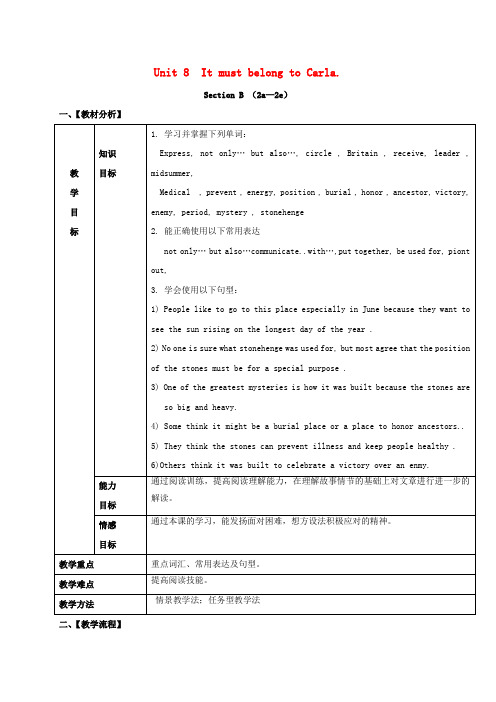
Medical , prevent , energy, position , burial , honor , ancestor, victory, enemy, period, mystery, stonehenge,
---It could be Carol’s. She studies French.
3)--What did you see that night?
-- I’m not sure, but it can’t be a dog . It was bigger. I think it might be a bear or a wolf.
4) Some think it might be a burial place or a place to honor ancestors..
5) They think the stones can prevent illness and keep people healthy .
6)Others think it was built to celebrate a victory over an enmy.
1) Make conversations to talk about guessing things.
e.g.:
1)–Whose coat is that?
--It can’t be John’s. It’s much too small for him.
2)—Whose book is that?
2.能正确使用以下常用表达
not only…but also…communicate..wБайду номын сангаасth…,put together, be used for, point out,
初中英语教资笔试教案模板必备范文

初中英语教资笔试教案模板必备范文全文共3篇示例,供读者参考篇1Middle School English Teaching Written Test Teaching Plan Template Essential SampleI. Teaching ContentUnit: Unit 1 - My FamilyTopic: Talking about family membersVocabulary: father, mother, sister, brother, grandfather, grandmother, aunt, uncle, cousinSentence Patterns: This is my father/mother/sister/brother...Skills: Listening, Speaking, Reading, WritingII. Teaching Objectives1. Students will be able to identify and name different family members in English.2. Students will be able to use the sentence pattern "This is my..." to introduce their family members.3. Students will be able to write short descriptions about their family members.III. Teaching Procedures1. Warm-up (10 minutes)- Greet the students and introduce the topic of the lesson.- Play a short video or show pictures of different family members and ask students to identify them.- Review the vocabulary words with the students.2. Presentation (15 minutes)- Introduce the sentence pattern "This is my..." and give examples with your own family members.- Have students practice the sentence pattern with their own family members in pairs.3. Practice (20 minutes)- Divide the class into small groups and give each group a set of picture cards with different family members.- Students take turns picking a card and using the sentence pattern to introduce the family member to their group.- Monitor and provide feedback as needed.4. Listening and Speaking (15 minutes)- Play a recording of a conversation between two people talking about their family members.- Have students listen and then answer questions about the conversation.- Pair students up and have them practice a similar conversation with their own family members.5. Reading (15 minutes)- Hand out a short reading passage about a family and ask students to read it silently.- Have students answer comprehension questions about the passage.- Read the passage aloud as a class and discuss the main points.6. Writing (15 minutes)- Ask students to write a short paragraph describing their own family members using the sentence pattern "This is my..."- Allow students to share their paragraphs with the class if they are comfortable.7. Wrap-up (10 minutes)- Review the main points of the lesson and do a quick quiz to assess student's understanding.- Assign homework for students to practice using the new vocabulary and sentence patterns.IV. Assessment- Use the student's written paragraphs and performance in the speaking activities to assess their understanding of the lesson objectives.- Provide feedback and extra practice for students who may be struggling.V. Materials- Picture cards of family members- Short reading passage about a family- Recording of a conversation about family members- Worksheets for comprehension questions and writing practiceVI. Follow-up Activities- Have students create a family tree or picture collage of their own family members to share with the class.- Play games or activities related to family members to reinforce vocabulary and sentence patterns.Overall, this lesson plan provides a structured and engaging way for students to learn about family members in English and practice using new vocabulary and sentence patterns. By incorporating a variety of activities and assessment methods, teachers can ensure that all students have the opportunity to succeed and improve their language skills.篇2Title: Essential Template for Junior High School English Teacher Qualification Exam Written Lesson PlanIntroduction:The Junior High School English Teacher Qualification Exam is an important assessment for aspiring English teachers. Along with the written test, candidates are required to submit a lesson plan showcasing their teaching methodology. In this article, we will provide an essential template for creating a comprehensive and effective lesson plan for the Junior High School English Teacher Qualification Exam.Lesson Plan Template:Title of Lesson: (e.g. Introduction to Present Simple Tense)Grade Level: (e.g. 8th Grade)Subject: EnglishTime Allotted: (e.g. 40 minutes)Objective: (e.g. Students will be able to understand and use the present simple tense in affirmative, negative, and interrogative forms.)Materials Needed: (e.g. whiteboard, markers, handouts, grammar worksheets)Procedure:1. Warm-up (5 minutes):- Engage students with a brief activity related to the present simple tense. For example, have students fill in the blanks with the correct form of the verb in the present simple tense.2. Introduction (10 minutes):- Provide a clear explanation of the present simple tense, its usage, and structure. Use visual aids and examples to help students understand the concept.3. Practice (15 minutes):- Distribute grammar worksheets or handouts with practice exercises. Monitor students as they work through the exercises, providing assistance when needed.4. Application (5 minutes):- Have students work in pairs or groups to create sentences using the present simple tense. Encourage them to be creative and use a variety of verbs.5. Review (5 minutes):- Review key points of the lesson and clarify any doubts or questions that students may have.6. Closure (5 minutes):- Summarize the lesson and assign homework, such as writing a short paragraph using the present simple tense.Assessment:- Evaluate students' understanding of the present simple tense through observation, class participation, and completion of practice exercises.Conclusion:Creating a well-structured lesson plan is essential for success in the Junior High School English Teacher Qualification Exam. By following this template and incorporating engaging activities and clear explanations, candidates can showcase their teaching abilities and effectively prepare students to understand and use the present simple tense.篇3Title: Essential Template for Junior High School English Teacher Qualification Written Examination Lesson PlanIntroduction:A well-structured lesson plan is essential for effective teaching, especially when preparing for the Junior High School English Teacher Qualification Written Examination. This document serves as a guide for English teachers to create a comprehensive and detailed lesson plan that covers various aspects of language learning and teaching.Lesson Plan Template:I. Lesson Title:II. Grade Level:III. Objective: (specific and measurable)IV. Prior Knowledge:V. Materials Needed:VI. Procedures:- Opening Activity: Engage students and introduce the topic - Presentation: Introduce new vocabulary and grammar rules- Practice: Provide activities for students to practice the new language- Application: Apply the new language in real-life situations - Closure: Summarize the lesson and provide feedbackVII. Assessment: (formative and summative)VIII. Differentiation: (accommodations for diverse learners) IX. Reflection: (what worked well, what needs improvement) X. Homework: (extension activities for practice)XI. Additional Notes: (any additional information relevant to the lesson)Sample Lesson Plan:I. Lesson Title: Present Simple TenseII. Grade Level: 7th GradeIII. Objective:- Students will be able to understand and use the present simple tense in affirmative, negative, and interrogative sentences.- Students will be able to apply the present simple tense in daily conversations and written exercises.IV. Prior Knowledge: Students have basic knowledge of verb tenses and subject-verb agreement.V. Materials Needed: Whiteboard, markers, handouts with examples, and practice activities.VI. Procedures:- Opening Activity: Review the concept of verb tense and introduce the present simple tense with examples.- Presentation: Explain the structure of affirmative, negative, and interrogative sentences in the present simple tense.- Practice: Provide exercises for students to practice forming sentences using the present simple tense.- Application: Have students work in pairs to create dialogues using the present simple tense.- Closure: Review the key points of the lesson and provide feedback to students.VII. Assessment:- Formative: Monitor students' participation and understanding during activities.- Summative: Evaluate students' performance in a written quiz on the present simple tense.VIII. Differentiation: Provide additional examples and practice activities for students who need extra help.IX. Reflection: Reflect on students' grasp of the present simple tense and adjust teaching strategies as needed.X. Homework: Assign students to create a short story using the present simple tense.XI. Additional Notes: Encourage students to practice using the present simple tense in their daily conversations outside of the classroom.Conclusion:By following this essential template for the Junior High School English Teacher Qualification Written Examination lesson plan, teachers can effectively organize and deliver engaging and informative English lessons. It is important to keep the objectives, activities, and assessments aligned to ensure students' success in language learning.。
2018下半年教师资格初中英语学科知识与教学能力试卷及答案

2018下半年教师资格初中英语学科知识与教学能力试卷及解答一、单项选择题(本大题共30小题。
每小题2分,共60分)1. Which of the following underlined parts is different from others in pronunciation?A. wishedB. jumpedC. kissedD. waited2. Which of the following shows the general intonation pattern in a complex sentence?A. When I started my↗career there was no↗unemployment.B. When I started my↗ career there was no↘ unemployment.C. When I started my↘career there was no ↗unemployment.D. When I started my↘ career there was no ↘ unemployment.3. All the_______in this school are taught by the same teacher.A. six-year-oldsB. six-years-oldC. six-year-oldD. six-years-olds4. The risk of infection for that patient hasn't diminished after the operation._______, it has increased.A. On the wholeB. On the contraryC. On the averageD. On the other hand5. Testing is still a usual means_______which students' progress is measured.A. inB. atC. ofD. by6. Many people_______in the project at both research and editing stages and we would like to thank them all here.A. have involvedB. have been involvedC. having involvedD. having been involved7. Only until very recently_______possible that grammarians are able to make accurate statements about the rules of some languages.A. has it beenB. it has beenC. was itD. it was8. This is not_______they had expected after years of painsta research.A. a result as bad asB. as a result as badC. as bad as a resultD. as bad a result as9. Which of the following words is formed through derivation?A. Students.B. Shorter.C. Bought.D. Insanity.10. The utterance “Now, correct me if I'm wrong ...”suggests that people are likely to observe the_______Maxim in daily conversations.A. QuantityB. QualityC. RelevanceD. Manner11. When a teacher asks students to brainstorm what they will write about an unforgettable trip,he/she mainly focuses on_______.A. ideasB. layoutC. styleD. feedback12. Which of the following is a communicative task?A. Reading aloud the dialogue on page 24.B. Writing a party invitation to your Mends.C. Translating the first paragraph into Chinese.D. Ma sentences with the expressions given.13. What is being practised if a teacher asks students to read words like "cot, hot" and "dog,log"?A. Spelling and structure.B. Stress and sound.C. Minimal pairs.D. Phonetic symbols.14. What teaching method is used by the teacher if much of his/her class time is spent on drilling sentence patterns followed by exercises like repetition, memorization, mimicry, etc.?A. The Natural Approach.B. The Communicative Approach.C. The Audio-lingual Method.D. The Grammar-translation Method.15. According to the affective-filter hypothesis,_______is NOT an affective factor influencing language learning.A. attitudeB. motivationC. interestD. intelligence16. What does his/her feedback focus on if a teacher's comment is “John, it would be much better if you have given more details,t”?A. Content.B. Language.C. Attitude.D. Aptitude.17. Which of the following is a referential question?A. Where was Yang Liwei born?B. Who is the first Chinese astronaut?C. Why do you think Yang Liwei is a great astronaut?D. When did Yang Liwei begin his historic space travel?18. Having lived in China for a long time, John could fully understand the cultural shocks experienced by his Chinese students. Which of the following traits does John have in this instance?A. Avoidance.B. Empathy.C. Extroversion.D. Introversion.19. When the teacher asks students to read a text for the main idea, he/she intends to develop students' skill of_______.A. retellingB. predictingC. skimmingD. scanning20. Which of the following is based on the communicative view of language?A. Structural syllabus.B. Skill-based syllabus.C. Genre-based syllabus.D. Functional-notional syllabus.请阅读 Passage 1,完成第21-25小题。
【初中英语】2018届九年级英语全一册教案+学案+试题(218份) 人教版144
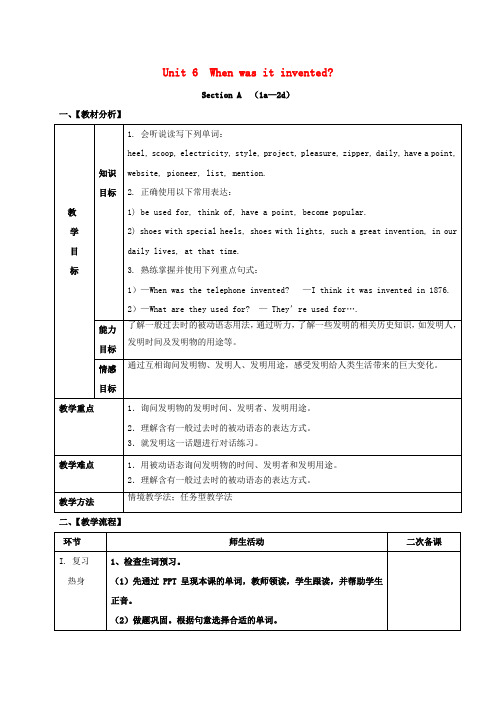
目标语言: A: I think … was invented before…. Ⅱ.感知 体验 B: Well, I think … was invented after …. A: When was the … invented? B: I think it was invented… 体验 1.课堂小游戏。全班分成两组,每组出四个代表。游戏规则:每组 的四名同学分别命名为 car, phone, computer, television,当一组同
(mentioned/mention) the pollution. 答案:① pleasure ② daily ③ style ④ website ⑤ mentioned 2、自由交谈 学生观看“外国人眼中的中国古代十大发明”视频片段,谈论以下两个 问题。 (1)What are the Four Great Inventions in ancient China? (2)Who invented them? Ss: Paper-making was invented by Cai Lun. …was invented by… 感知 1. 用 PPT 呈现下列图片和目标语言。
学问出 When was the car invented? 另外一组叫 car 的同学要马上说 出 I think it was invented in 1885,然后游戏继续,由 car 继续发 问。答题过慢,时间说错或句法有问题都算错。 感知 2.用 PPT 出示一系列问题(见课件),引导学生找出本小节的目 标语言和单词词组。 目标语言:What are they used for? They are used for…. 单词词组: heel, scoop, electricity, style, shoes with special heels, shoes with lights,be used for… 体验 2. 小组之间进行对话练习 A: How about the shoes with lights, what are they used for? B: They are used for seeing in the dark when you get up at night. 感知 3. 通过问题提示阅读的方式(见课件),学生找出 2d 部分的目标 语言和单词词组。 目标语言:When was the zipper invented? It was invented in 1893. Who was it invented by? It was invented by Whitcomb Judson. 单词词组:project, pleasure, zipper, daily, have a point, website, pioneer, list, mention,such a great invention, in our daily lives, at that time 体验 3. 小组比赛,看哪个小组能熟练复述本段对话。 1. 处理教材 1a,1b,1c 的内容。 (1) Look at the things below. Then number them [1—4] (1=first, 4=last). 答案: 4 2 1 3 Ⅲ.强化 巩固 (2) Listen and match the inventions with the years. 答案: d a c b (3) Student B, cover the dates. Student A, ask Student B when the things in the picture in 1b were invented. Then charge roles and practice again. —When was the telephone invented?
2018年上半年教师资格证考试英语学科知识与教学能力真题(初级中学)

2018年上半年教师资格证考试英语学科知识与教学能力真题(初级中学)(总分:150.00,做题时间:120分钟)一、单项选择题本大题共 30 小题,每小题 2 分,共 60 分。
在每小题列出的四个备选项中只有一个是符合题目要求的,错选、多选或未选均无分。
(总题数:22,分数:60.00)1.The similarity between the English consonants /p/, /b/, and /m/ is that they are allA.fricativeB.plosivebial-dentalD.bilabial √解析:本题考查辅音的分类。
根据辅音的分类,按照发音部位,/p/,/b/,/m/ 都属于双唇音(bilabial);按照发音方式,/p/,/b/是爆破音(plosive),/m/是鼻音(nasal)。
故本题选 D。
2.Which of the following is a back vowel in English?A./ə:/B./ɔ:/ √C./ʌ/D./e/解析:本题考查元音的分类。
根据元音的分类,可知/ə:/属于中元音,/ɔ:/属于后元音,/e/属于前元音。
但/ʌ/比较特殊,发此音时舌头的最高位置偏中后,所以有的分类系统会把它归为中元音,也有的把它归为后元音,考生在做此类题时要根据选择项的情况灵活处理。
3.There is only one playground slide in this school, so the students have to take( ) to use it.A.turns √B.the turnsC.a turnD.the turn解析:本题考查习惯搭配。
句意为“因为学校只有一个滑梯,所以学生们不得不轮流使用”。
take turns to do sth.为习惯搭配,意为“轮流去做某事”。
故本题选 A。
4.Out of everyone’s expectation, Johnson suddenly returned ( ) a rainy night.A.atB.inC.on √D.during解析:本题考查介词用法。
2018初中英语教学设计
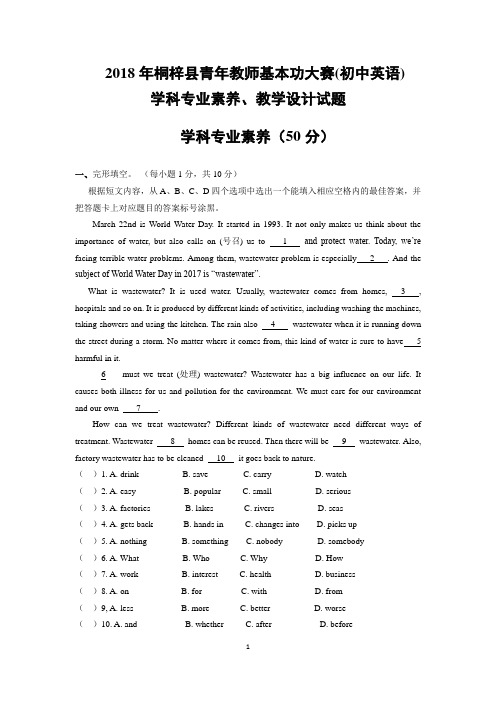
2018年桐梓县青年教师基本功大赛(初中英语)学科专业素养、教学设计试题学科专业素养(50分)一、完形填空。
(每小题1分,共10分)根据短文内容,从A、B、C、D四个选项中选出一个能填入相应空格内的最佳答案,并把答题卡上对应题目的答案标号涂黑。
March 22nd is World Water Day. It started in 1993. It not only makes us think about the importance of water, but also calls on (号召) us to 1 and protect water. Today, we’re facing terrible water problems. Among them, wastewater problem is especially 2 . And the subject of World Water Day in 2017 is “wastewater”.What is wastewater? It is used water. Usually, wastewater comes from homes, 3 , hospitals and so on. It is produced by different kinds of activities, including washing the machines, taking showers and using the kitchen. The rain also 4 wastewater when it is running down the street during a storm. No matter where it comes from, this kind of water is sure to have 5 harmful in it.___6___ must we treat (处理) wastewater? Wastewater has a big influence on our life. It causes both illness for us and pollution for the environment. We must care for our environment and our own 7 .How can we treat wastewater? Different kinds of wastewater need different ways of treatment. Wastewater 8 homes can be reused. Then there will be 9 wastewater. Also, factory wastewater has to be cleaned 10 it goes back to nature.()1. A. drink B. save C. carry D. watch()2. A. easy B. popular C. small D. serious()3. A. factories B. lakes C. rivers D. seas()4. A. gets back B. hands in C. changes into D. picks up()5. A. nothing B. something C. nobody D. somebody()6. A. What B. Who C. Why D. How()7. A. work B. interest C. health D. business()8. A. on B. for C. with D. from()9, A. less B. more C. better D. worse()10. A. and B. whether C. after D. before二. 阅读理解。
初中英语教资教学设计模板
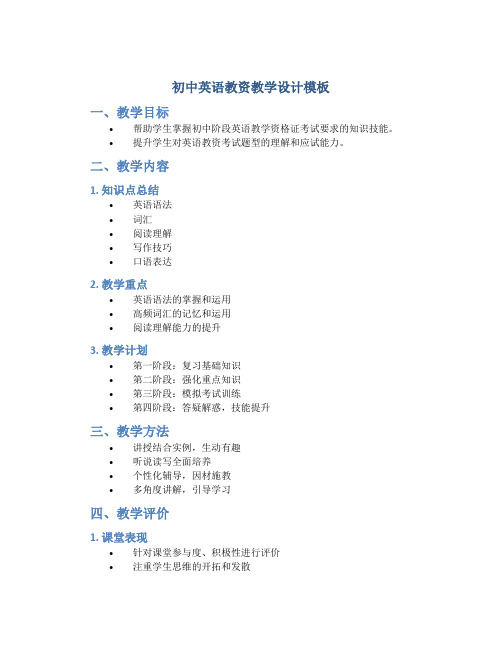
初中英语教资教学设计模板
一、教学目标
•帮助学生掌握初中阶段英语教学资格证考试要求的知识技能。
•提升学生对英语教资考试题型的理解和应试能力。
二、教学内容
1. 知识点总结
•英语语法
•词汇
•阅读理解
•写作技巧
•口语表达
2. 教学重点
•英语语法的掌握和运用
•高频词汇的记忆和运用
•阅读理解能力的提升
3. 教学计划
•第一阶段:复习基础知识
•第二阶段:强化重点知识
•第三阶段:模拟考试训练
•第四阶段:答疑解惑,技能提升
三、教学方法
•讲授结合实例,生动有趣
•听说读写全面培养
•个性化辅导,因材施教
•多角度讲解,引导学习
四、教学评价
1. 课堂表现
•针对课堂参与度、积极性进行评价
•注重学生思维的开拓和发散
2. 作业评定
•定期布置作业,检测学生掌握程度
•作业评定要求认真、细致
3. 考试成绩
•定期模拟考试,检验学生学习效果
•结果分析,帮助学生及时调整学习策略
五、教学辅助
•利用多媒体教学,呈现生动形象的教学内容
•提供辅导资料,方便学生课后复习
•结合线上资源,拓展学习渠道
六、教学反思
•不断总结优化教学方法
•分析学生学习状况,及时调整教学方向
初中英语教资教学设计模板可以帮助教师高效规划教学内容,引导学生有目的、有计划地备考英语教资考试。
通过科学的教学设计,提高学生的学习兴趣和学习效率,达到更好的教学效果。
(完整版)2018年最新初中英语教资考试教学设计题模板
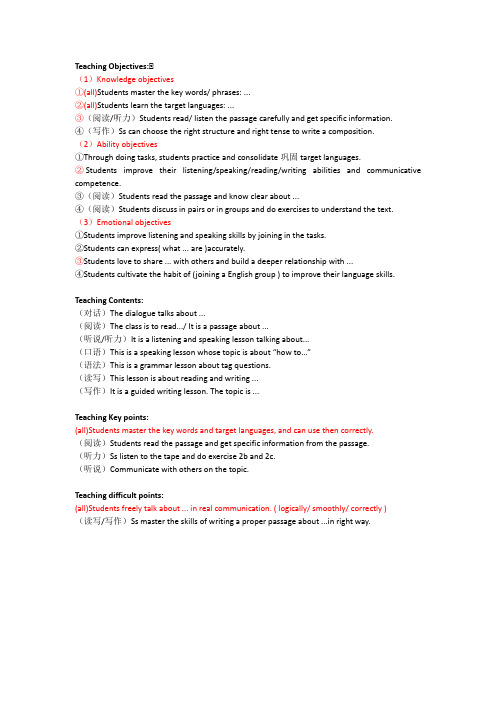
(1)Knowledge objectives①(all)Students master the key words/ phrases: ...②(all)Students learn the target languages: ...③(阅读/听力)Students read/ listen the passage carefully and get specific information.④(写作)Ss can choose the right structure and right tense to write a composition.(2)Ability objectives①Through doing tasks, students practice and consolidate巩固target languages.②Students improve their listening/speaking/reading/writing abilities and communicative competence.③(阅读)Students read the passage and know clear about ...④(阅读)Students discuss in pairs or in groups and do exercises to understand the text.(3)Emotional objectives①Students improve listening and speaking skills by joining in the tasks.②Students can express( what ... are )accurately.③Students love to share ... with others and build a deeper relationship with ...④Students cultivate the habit of (joining a English group ) to improve their language skills.Teaching Contents:(对话)The dialogue talks about ...(阅读)The class is to read.../ It is a passage about ...(听说/听力)It is a listening and speaking lesson talking about...(口语)This is a speaking lesson whose topic is about “how to...”(语法)This is a grammar lesson about tag questions.(读写)This lesson is about reading and writing ...(写作)It is a guided writing lesson. The topic is ...Teaching Key points:(all)Students master the key words and target languages, and can use then correctly.(阅读)Students read the passage and get specific information from the passage.(听力)Ss listen to the tape and do exercise 2b and 2c.(听说)Communicate with others on the topic.Teaching difficult points:(all)Students freely talk about ... in real communication. ( logically/ smoothly/ correctly )(读写/写作)Ss master the skills of writing a proper passage about ...in right way.Step 1 Lead-in ( 5 minutes)Activity 1: ReviewT: What ... do you learn in school? Can you say it in English?(Justification: Reviewing what ss have learned can help ss get ready for the new lesson. ) Activity 2: Sing a song/ Play a short filmThe teacher guides ss to sing a song .../ plays a short film(Justification: Sing a song/ play a film clip that is closely related to the topic of the lesson can arouse ss’ learning interest.)Activity 3: Free talk(Justification: Through free talk, ss get prepared to listening tasks. / help ss know what they will learn in class. )听力课Step 1 Pre-listening ( 5 minutes )Activity : Free talkT: Good morning! Look at ... So tell me ...(Justification: Free talk will attract ss’ interest and teaching content would be naturally led in.) Step 2 While-listening ( 25 minutes)Activity 1: Listen to the tape and finish exercise 2b./ summarize the main idea of the conversation.Activity 2:Listen again. Make up a dialogue according the content of tape. ( T: Talk about ... ) (Teacher show the tapescript on the PPT. Ss read the conversation and circle the key words and sentences in the conversation. The teacher write these on the blackboard such as “...”) Activity 3: Give a report. ( T: Several groups come to the front to act out your dialogue, and others give some evaluation. )(Justification: Through listening and speaking activities, ss master the language knowledge and improve language skills.)Step 3 Post-listening ( 10 minutes)Activity 1: Discussion. (T: Talk about ...)(Justification: Ss use the language knowledge in real communication, which can associate the knowledge with real life.联系)Activity 2: Make a dialogue.Ss work in groups of four to make up a new dialogue by imitating the conversation, especially by using the key words and sentences in the conversation.Activity 3: Role play.Ss act out their dialogue group by group. When one group is acting, the teacher and other ss act as judges. After the performance, the teacher corrects the common language mistakes. At the end, the whole class select one group who performs the best.(Justification: Ss develop their speaking skills and also apply the key knowledge into practice. )Step 1 Pre-task ( 3 minutes)Activity 1: BrainstormT: Please brainstorm about...(The teacher writes down on the blackboard the key words that ss have mentioned )(Justification: Talking about the topic in a real situation can arouse ss’ interest to communicate. ) Step 2 Task-cycle ( 15 minutes)Activity 1: ListeningSs listen to the tape for three times, take notes and finish exercise in the textbook. (Justification: The listening task is language input activity, which will help ss output more language information in the next activity. )Activity 2: Group discussionSs discuss in groups of four about ..., the teacher walk around and give guidance. Several minutes later, they share their ideas in the class group by group.(Justification: Ss improve their listening and speaking abilities and communicative competence.) Step 3 Language focus ( 2 minutes )The teacher guides ss to notice and conclude the target language they used. Then, the teacher writes them on the blackboard.Activity 1: Write a short passageSs are asked to write a short passage to ...(Justification: This step draw ss’attention to the language patterns, which is good for their accurate use of language. )Step 2 Presentation and practice ( 15 minutes)(Show a picture of ...)Activity 1: Question and AnswerActivity 2: Pair workT: Good job. OK, now ask your partner with the sentence “...?” and answer it by “...”.Then tell your reasons.Begin....T: Time is up. Do you know ...?S:Yes.T: Excellent. Who wants to cat out your dialogue?(Justification: To present the new words with pictures and to practice sentences in pair game are good for students to learn and master the target language.)Step 3 Consolidation巩固( 20 minutes)Activity 1: Listen and DiscussT: Now, listen to the tape and find out ...(gist).The tape will be played for three times.At the first time you should summarize the main idea. At the second time, you should listen carefully and circle (new words) that you heard on the blackboard.At third time check your answer.OK?T: Do you understand what the material(材料)is about? Discuss with your partner and find out the right answer.OK?(Then check the answers with whole class.)Activity 2: Make a dialogue/ Pair workT:Make a short conversation by imitating the listening material in pairs.(Five minutes later, the teacher encourages some ss to act out their dialogue.)(Justification: In this step, the purpose is to train ss’ listening and speaking skills. )Step 2 Pre-reading ( 5 minutes)Then ss are encouraged to talk about ... in group of four. Then the teacher asks some volunteers to give a report.(Justification: Through talking about ... , ss perceive感知the language used to ... )Step 3 While-reading ( 15 minutes)Activity 1: Fast readingSs are given one minute to read the short passage quickly, and then conclude the main idea.Activity 2: Careful readingSs are given 5 minutes to read the passage again, then do two exercise:(1)Answer the following questions in order to grasp the detailed information of the passage.①②answer: ①②(2)Read the passage and complete the sentences.①②answer:①②(Justification: The two activities will help ss understand the passage and also train their reading skills.)Step 4 Post-reading ( 15 minutes)Ss write a short passage about ...by imitating the given passage. Then they peer edit each other’s writing and give reasonable suggestions. Students revise their writing and hand in the final draft. (Justification: Ss apply the knowledge they just learned into practice.)Step 2 Presentation ( 5 minutes )The teacher shows the dialogue on the PPT, and asks ss to read the conversation. The teacher instructs them to conclude the usage of ...(Justification: Learning the grammar in inductive way can arouse ss’ learning interest and deepen their understanding of the grammar.)Step 3 Practice ( 8 minutes )Activity 1: Fill in the blanksThe teacher writes down some sentences of ... on the blackboard and asks ss to fill in the blanks with the guidance of the rule they conclude.①②③Answer:①②③After ss finish the exercise, the teacher checks their answer, leads ss to summarize the rule of target language with ss.Activity 2: True or falseThe teacher presents the sentences on the PPT and asks ss to judge which is true and which is false. Such as:①②③Answer:①②③(Justification: The two exercise can check and consolidate ss’ mastery of the grammar. )读写课Step 2 Pre-writing ( 5 minutes )The teacher guides ss to read the passage for two times and find out (the key words and target languages).(Justification: Reading the passage can make ss have a clear understanding of the structure and contents.)Step 3 While-writing ( 20 minutes )Firstly, the teacher shows the format格式and the writing standards标准of ... And then ss should write a first draft by imitating the passage.Secondly, the teacher lets ss revise 修改their letter, especially the spelling and grammar mistakes. At the same time, the teacher walks around the classroom to give them guidance. (Justification: Showing the format and writing standards can help ss polish their own passage. The activity of revising can improve their thinking and writing ability.)Step 4 Post-writing ( 10 minutes )The teacher corrects some common mistakes and makes a comment on the writing (Justification: This step can help ss master some useful writing skills.)Step 1 Pre-writing ( 5 minutes )Activity 1: BrainstormingThe teacher show some photos of ..., and asks ss ... The teacher lists down ss’ideas on the blackboard.(Justification: Brainstorming can activate ss’ thinking, enlarge ss’ language output, and help ss get prepared to write a composition. )Step 2 While-writing ( 10 minutes )Ss are given 5 minutes to write their first draft. When ss are writing, the teacher should walk around the classroom and give them guidance.Activity 1: pair workSs work in pairs to discuss and edit each other’s competition for about 3 minutes. Then ss repolish the second draft.Step 3 Post-writing ( 5 minutes )The teacher corrects the common mistakes and leads the whole class to conclude得出结论the writing essentials必要因素. Ss are asked to hand in their final draft. After the teacher reads over all the composition, he will choose three best ones to exhibit in the class.(Justification: In this step, ss get more information about how to write a better competition. )Step N Summary and homework ( 5 minutes)Students summarize the important points of the lesson, and the teacher gives a further conclusion with the blackboard design.Homework:①Review the words and sentences learned in this class.②实践类作业Make a survey:ask your friends: ——...? And the reasons. (Justification: Extend the classroom knowledge to ss’real life. It is good for ss to apply the knowledge into practice.)③Write a short passage to record what they have learned in the class.(Justification: The summary and homework will help ss review what they have learned in this class.)④Ss rewrite a passage on the topic and hand in the final draft.Board Plan:Words Sentencealoud,pronunciation What about...? Have you...?。
2018年初中英语教资考试教学设计题模板

(1)Knowledge objectives①(all)Students master the key words/ phrases: ...②(all)Students learn the target languages: ...③(阅读/听力)Students read/ listen the passage carefully and get specific information.④(写作)Ss can choose the right structure and right tense to write a composition.(2)Ability objectives①Through doing tasks, students practice and consolidate巩固target languages.②Students improve their listening/speaking/reading/writing abilities and communicative competence.③(阅读)Students read the passage and know clear about ...④(阅读)Students discuss in pairs or in groups and do exercises to understand the text.(3)Emotional objectives①Students improve listening and speaking skills by joining in the tasks.②Students can express( what ... are )accurately.③Students love to share ... with others and build a deeper relationship with ...④Students cultivate the habit of (joining a English group ) to improve their language skills.Teaching Contents:(对话)The dialogue talks about ...(阅读)The class is to read.../ It is a passage about ...(听说/听力)It is a listening and speaking lesson talking about...(口语)This is a speaking lesson whose topic is about “how to...”(语法)This is a grammar lesson about tag questions.(读写)This lesson is about reading and writing ...(写作)It is a guided writing lesson. The topic is ...Teaching Key points:(all)Students master the key words and target languages, and can use then correctly.(阅读)Students read the passage and get specific information from the passage.(听力)Ss listen to the tape and do exercise 2b and 2c.(听说)Communicate with others on the topic.Teaching difficult points:(all)Students freely talk about ... in real communication. ( logically/ smoothly/ correctly )(读写/写作)Ss master the skills of writing a proper passage about ...in right way.Step 1 Lead-in ( 5 minutes)Activity 1: ReviewT: What ... do you learn in school? Can you say it in English?(Justification: Reviewing what ss have learned can help ss get ready for the new lesson. ) Activity 2: Sing a song/ Play a short filmThe teacher guides ss to sing a song .../ plays a short film(Justification: Sing a song/ play a film clip that is closely related to the topic of the lesson can arouse ss’ learning interest.)Activity 3: Free talk(Justification: Through free talk, ss get prepared to listening tasks. / help ss know what they will learn in class. )听力课Step 1 Pre-listening ( 5 minutes )Activity : Free talkT: Good morning! Look at ... So tell me ...(Justification: Free talk will attract ss’ interest and teaching content would be naturally led in.) Step 2 While-listening ( 25 minutes)Activity 1: Listen to the tape and finish exercise 2b./ summarize the main idea of the conversation.Activity 2:Listen again. Make up a dialogue according the content of tape. ( T: Talk about ... ) (Teacher show the tapescript on the PPT. Ss read the conversation and circle the key words and sentences in the conversation. The teacher write these on the blackboard such as “...”) Activity 3: Give a report. ( T: Several groups come to the front to act out your dialogue, and others give some evaluation. )(Justification: Through listening and speaking activities, ss master the language knowledge and improve language skills.)Step 3 Post-listening ( 10 minutes)Activity 1: Discussion. (T: Talk about ...)(Justification: Ss use the language knowledge in real communication, which can associate the knowledge with real life.联系)Activity 2: Make a dialogue.Ss work in groups of four to make up a new dialogue by imitating the conversation, especially by using the key words and sentences in the conversation.Activity 3: Role play.Ss act out their dialogue group by group. When one group is acting, the teacher and other ss act as judges. After the performance, the teacher corrects the common language mistakes. At the end, the whole class select one group who performs the best.(Justification: Ss develop their speaking skills and also apply the key knowledge into practice. )Step 1 Pre-task ( 3 minutes)Activity 1: BrainstormT: Please brainstorm about...(The teacher writes down on the blackboard the key words that ss have mentioned )(Justification: Talking about the topic in a real situation can arouse ss’ interest to communicate. ) Step 2 Task-cycle ( 15 minutes)Activity 1: ListeningSs listen to the tape for three times, take notes and finish exercise in the textbook. (Justification: The listening task is language input activity, which will help ss output more language information in the next activity. )Activity 2: Group discussionSs discuss in groups of four about ..., the teacher walk around and give guidance. Several minutes later, they share their ideas in the class group by group.(Justification: Ss improve their listening and speaking abilities and communicative competence.) Step 3 Language focus ( 2 minutes )The teacher guides ss to notice and conclude the target language they used. Then, the teacher writes them on the blackboard.Activity 1: Write a short passageSs are asked to write a short passage to ...(Justification: This step draw ss’attention to the language patterns, which is good for their accurate use of language. )Step 2 Presentation and practice ( 15 minutes)(Show a picture of ...)Activity 1: Question and AnswerActivity 2: Pair workT: Good job. OK, now ask your partner with the sentence “...?” and answer it by “...”.Then tell your reasons.Begin....T: Time is up. Do you know ...?S:Yes.T: Excellent. Who wants to cat out your dialogue?(Justification: To present the new words with pictures and to practice sentences in pair game are good for students to learn and master the target language.)Step 3 Consolidation巩固( 20 minutes)Activity 1: Listen and DiscussT: Now, listen to the tape and find out ...(gist).The tape will be played for three times.At the first time you should summarize the main idea. At the second time, you should listen carefully and circle (new words) that you heard on the blackboard.At third time check your answer.OK?T: Do you understand what the material(材料)is about? Discuss with your partner and find out the right answer.OK?(Then check the answers with whole class.)Activity 2: Make a dialogue/ Pair workT:Make a short conversation by imitating the listening material in pairs.(Five minutes later, the teacher encourages some ss to act out their dialogue.)(Justification: In this step, the purpose is to train ss’ listening and speaking skills. )Step 2 Pre-reading ( 5 minutes)Then ss are encouraged to talk about ... in group of four. Then the teacher asks some volunteers to give a report.(Justification: Through talking about ... , ss perceive感知the language used to ... )Step 3 While-reading ( 15 minutes)Activity 1: Fast readingSs are given one minute to read the short passage quickly, and then conclude the main idea.Activity 2: Careful readingSs are given 5 minutes to read the passage again, then do two exercise:(1)Answer the following questions in order to grasp the detailed information of the passage.①②answer: ①②(2)Read the passage and complete the sentences.①②answer:①②(Justification: The two activities will help ss understand the passage and also train their reading skills.)Step 4 Post-reading ( 15 minutes)Ss write a short passage about ...by imitating the given passage. Then they peer edit each other’s writing and give reasonable suggestions. Students revise their writing and hand in the final draft. (Justification: Ss apply the knowledge they just learned into practice.)Step 2 Presentation ( 5 minutes )The teacher shows the dialogue on the PPT, and asks ss to read the conversation. The teacher instructs them to conclude the usage of ...(Justification: Learning the grammar in inductive way can arouse ss’ learning interest and deepen their understanding of the grammar.)Step 3 Practice ( 8 minutes )Activity 1: Fill in the blanksThe teacher writes down some sentences of ... on the blackboard and asks ss to fill in the blanks with the guidance of the rule they conclude.①②③Answer:①②③After ss finish the exercise, the teacher checks their answer, leads ss to summarize the rule of target language with ss.Activity 2: True or falseThe teacher presents the sentences on the PPT and asks ss to judge which is true and which is false. Such as:①②③Answer:①②③(Justification: The two exercise can check and consolidate ss’ mastery of the grammar. )读写课Step 2 Pre-writing ( 5 minutes )The teacher guides ss to read the passage for two times and find out (the key words and target languages).(Justification: Reading the passage can make ss have a clear understanding of the structure and contents.)Step 3 While-writing ( 20 minutes )Firstly, the teacher shows the format格式and the writing standards标准of ... And then ss should write a first draft by imitating the passage.Secondly, the teacher lets ss revise 修改their letter, especially the spelling and grammar mistakes. At the same time, the teacher walks around the classroom to give them guidance. (Justification: Showing the format and writing standards can help ss polish their own passage. The activity of revising can improve their thinking and writing ability.)Step 4 Post-writing ( 10 minutes )The teacher corrects some common mistakes and makes a comment on the writing (Justification: This step can help ss master some useful writing skills.)Step 1 Pre-writing ( 5 minutes )Activity 1: BrainstormingThe teacher show some photos of ..., and asks ss ... The teacher lists down ss’ideas on the blackboard.(Justification: Brainstorming can activate ss’ thinking, enlarge ss’ language output, and help ss get prepared to write a composition. )Step 2 While-writing ( 10 minutes )Ss are given 5 minutes to write their first draft. When ss are writing, the teacher should walk around the classroom and give them guidance.Activity 1: pair workSs work in pairs to discuss and edit each other’s competition for about 3 minutes. Then ss repolish the second draft.Step 3 Post-writing ( 5 minutes )The teacher corrects the common mistakes and leads the whole class to conclude得出结论the writing essentials必要因素. Ss are asked to hand in their final draft. After the teacher reads over all the composition, he will choose three best ones to exhibit in the class.(Justification: In this step, ss get more information about how to write a better competition. )Step N Summary and homework ( 5 minutes)Students summarize the important points of the lesson, and the teacher gives a further conclusion with the blackboard design.Homework:①Review the words and sentences learned in this class.②实践类作业Make a survey:ask your friends: ——...? And the reasons. (Justification: Extend the classroom knowledge to ss’real life. It is good for ss to apply the knowledge into practice.)③Write a short passage to record what they have learned in the class.(Justification: The summary and homework will help ss review what they have learned in this class.)④Ss rewrite a passage on the topic and hand in the final draft.Board Plan:Words Sentencealoud,pronunciation What about...? Have you...?。
教资笔试科三初中英语教案模板

课题:《Unit 4 I want to be an actor》课时:2课时教学目标:1. 学生能够正确拼读并理解本单元的生词和短语。
2. 学生能够运用本单元的句型进行日常交际。
3. 学生能够通过小组合作,提高英语听说能力。
教学重点:1. 生词和短语的拼读和运用。
2. 句型的正确使用。
教学难点:1. 生词和短语的记忆。
2. 句型的灵活运用。
教学过程:第一课时:一、导入1. 利用图片展示本课的主题:actor,引导学生说出与之相关的词汇。
2. 通过提问,引导学生对本课主题产生兴趣。
二、新课导入1. 教师带领学生朗读课文,让学生初步了解文章大意。
2. 学生跟读课文,注意语音、语调。
三、词汇教学1. 教师板书生词和短语,带领学生朗读,让学生正确拼读。
2. 学生分组,进行词汇接龙游戏,巩固生词。
四、句型教学1. 教师引导学生根据课文内容,运用所学句型进行对话。
2. 学生分组,进行角色扮演,运用句型进行交际。
五、练习1. 学生完成课后练习题,巩固所学知识。
2. 教师检查学生的练习情况,给予个别辅导。
第二课时:一、复习导入1. 教师带领学生复习上一节课的生词和短语。
2. 学生进行小组讨论,运用所学句型进行交际。
二、课文精讲1. 教师引导学生分析课文结构,理解课文内容。
2. 学生跟读课文,注意语音、语调。
三、听力训练1. 教师播放听力材料,学生完成听力练习。
2. 学生讨论听力材料,分享自己的理解。
四、口语训练1. 教师引导学生进行口语交际,运用所学句型进行对话。
2. 学生分组,进行角色扮演,提高口语表达能力。
五、总结与作业1. 教师对本节课所学内容进行总结,强调重点和难点。
2. 学生完成课后作业,巩固所学知识。
教学反思:本节课通过多种教学方法,如游戏、小组合作、角色扮演等,激发了学生的学习兴趣,提高了学生的英语听说能力。
在教学过程中,要注意以下几点:1. 注重生词和短语的拼读和运用,帮助学生牢固记忆。
2. 引导学生正确使用句型,提高学生的英语交际能力。
英语教资教案模板初中

英语教资教案模板初中一、教学目标1. 知识目标(1)能够理解并掌握本课的主要词汇和短语。
(2)能够正确运用本课所学的句型进行简单的交流。
(3)能够听懂、说懂、读懂本课的内容。
2. 能力目标(1)能够通过阅读、听力等方式获取信息,并能够进行简单的信息处理。
(2)能够通过听、说、读、写等方式表达自己的观点和感受。
3. 情感目标(1)能够积极参与课堂活动,与老师和同学进行良好的互动。
(2)能够培养对英语学习的兴趣和自信心。
二、教学内容1. 主要词汇和短语(1)列出本课的主要词汇和短语。
(2)通过图片、例句等方式帮助学生理解和记忆词汇和短语。
2. 主要句型(1)介绍本课的主要句型。
(2)通过例句、练习等方式帮助学生理解和运用句型。
3. 课文内容(1)介绍本课的课文内容。
(2)通过阅读、讨论等方式帮助学生理解和掌握课文内容。
三、教学步骤1. 导入(1)通过图片、问题等方式引起学生的兴趣,导入新课。
2. 呈现(1)通过图片、实物等方式呈现本课的主要词汇和短语。
(2)通过例句、练习等方式呈现本课的主要句型。
3. 练习(1)通过小组活动、游戏等方式让学生进行词汇和句型的练习。
4. 阅读(1)让学生阅读课文,理解课文内容。
(2)通过问题、讨论等方式帮助学生理解课文内容。
5. 输出(1)通过角色扮演、写作等方式让学生运用所学知识进行输出。
6. 总结(1)对本课的主要内容进行总结。
(2)布置作业,让学生进行巩固练习。
四、教学评价1. 课堂参与度(1)观察学生在课堂活动中的参与情况,是否积极回答问题,与同学进行互动。
2. 知识掌握情况(1)通过课堂练习、作业等方式检查学生对词汇和短语的掌握情况。
(2)通过课堂练习、作业等方式检查学生对句型的掌握情况。
3. 情感态度(1)观察学生在课堂活动中的情感态度,是否积极、自信。
五、教学资源1. 图片、实物等教学资源。
2. 录音机、课件等教学设备。
六、教学建议1. 针对不同学生的学习情况,可以适当调整教学内容和教学方式。
【初中英语】2018届九年级英语全一册教案+学案+试题(218份) 人教版97
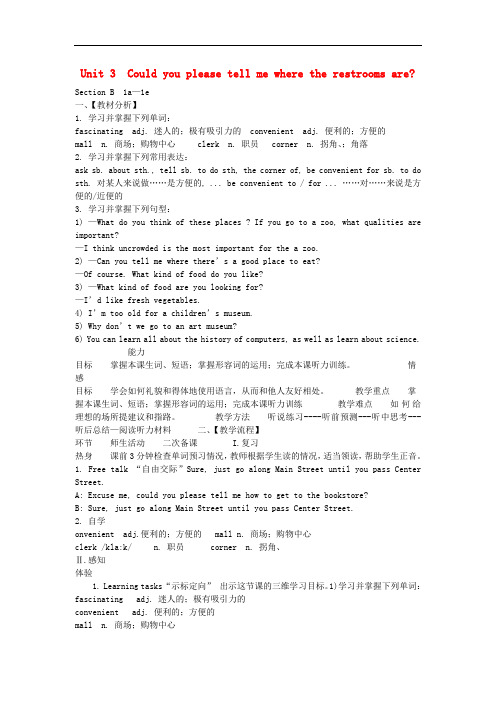
Unit 3 Could you please tell me where the restrooms are?Section B 1a—1e一、【教材分析】1. 学习并掌握下列单词:fascinating adj. 迷人的;极有吸引力的 convenient adj. 便利的;方便的mall n. 商场;购物中心 clerk n. 职员 corner n. 拐角、;角落2. 学习并掌握下列常用表达:ask sb. about sth., tell sb. to do sth, the corner of, be convenient for sb. to do sth. 对某人来说做……是方便的, ... be convenient to / for ... ……对……来说是方便的/近便的3. 学习并掌握下列句型:1) —What do you think of these places ? If you go to a zoo, what qualities are important?—I think uncrowded is the most important for the a zoo.2) —Can you tell me where there’s a good place to eat?—Of course. What kind of food do you like?3) —What kind of food are you looking for?—I’d like fresh vegetables.4) I’m too old for a children’s museum.5) Why don’t we go to an art museum?6) You can learn all about the history of computers, as well as learn about science.能力目标掌握本课生词、短语;掌握形容词的运用;完成本课听力训练。
最新2018年初中英语教学设计模板
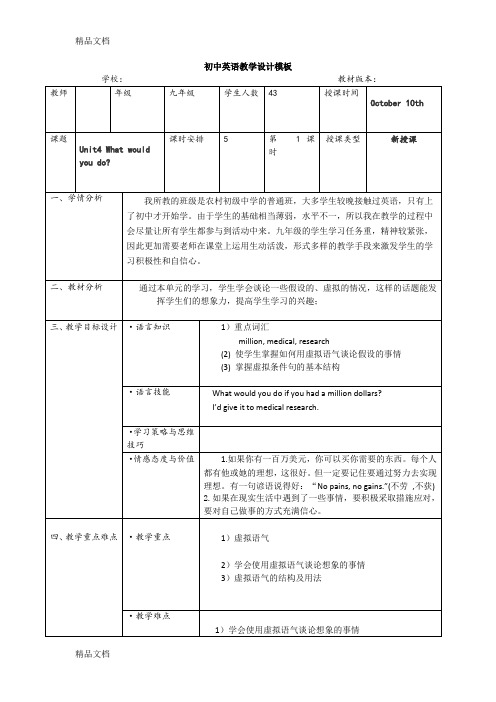
(三)DIY手工艺品的“自助化”1、突出重点,突破难点:通过听力训练、句型展示、小组活动等多种形式反复操练重点句型,巩固所学知识,提高灵活运用能力,通过操练和幻灯片展示帮助学生更好地领会语法。
2、任务型教学法:倡导体验参与,培养自主学习能力。先创设语境让他们感知,然后在让他们自己归纳出虚拟语气的结构,这样他们就会有一种成功感,从而提高学习的兴趣。
教师活动
T:Look at the pictures. Talk with your partner about what would he /she do if he/she had one million dollars.
设计意图
提高听力技能
教学环节4
教学过程
This activity provides oral practice using the target language.
Call students’ attention to the conversation in the box. Explain the vocabulary words million and medical research
I’d give it to medical research.
·学习策略与思维技巧
·情感态度与价值
1.如果你有一百万美元,你可以买你需要的东西。每个人都有他或她的理想,这很好。但一定要记住要通过努力去实现理想。有一句谚语说得好:“No pains, no gains.”(不劳,不获)
2.如果在现实生活中遇到了一些事情,要积极采取措施应对,要对自己做事的方式充满信心。
教师活动
T:Look at the pictures. Talk with your partner about what would he /she do if he/she had one million dollars.
初中英语教资教案题模板
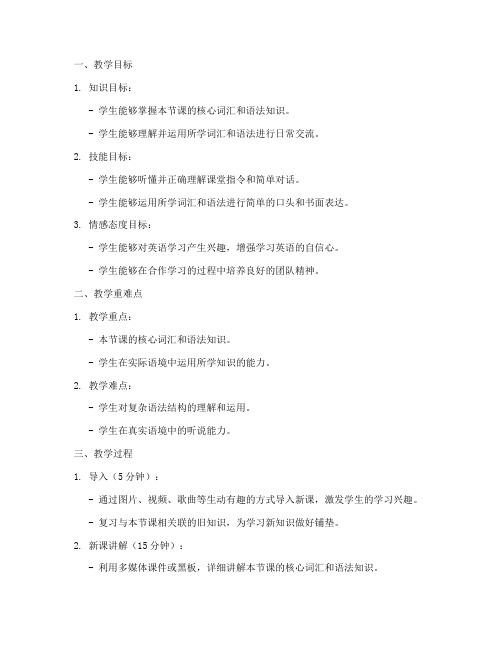
一、教学目标1. 知识目标:- 学生能够掌握本节课的核心词汇和语法知识。
- 学生能够理解并运用所学词汇和语法进行日常交流。
2. 技能目标:- 学生能够听懂并正确理解课堂指令和简单对话。
- 学生能够运用所学词汇和语法进行简单的口头和书面表达。
3. 情感态度目标:- 学生能够对英语学习产生兴趣,增强学习英语的自信心。
- 学生能够在合作学习的过程中培养良好的团队精神。
二、教学重难点1. 教学重点:- 本节课的核心词汇和语法知识。
- 学生在实际语境中运用所学知识的能力。
2. 教学难点:- 学生对复杂语法结构的理解和运用。
- 学生在真实语境中的听说能力。
三、教学过程1. 导入(5分钟):- 通过图片、视频、歌曲等生动有趣的方式导入新课,激发学生的学习兴趣。
- 复习与本节课相关联的旧知识,为学习新知识做好铺垫。
2. 新课讲解(15分钟):- 利用多媒体课件或黑板,详细讲解本节课的核心词汇和语法知识。
- 结合实际例句,帮助学生理解并掌握所学知识。
- 通过提问、互动等方式,检查学生对知识的掌握情况。
3. 练习环节(15分钟):- 设计丰富多彩的练习活动,如听力练习、口语练习、阅读练习、写作练习等。
- 引导学生运用所学知识进行实际操作,巩固所学知识。
4. 巩固环节(10分钟):- 通过小组讨论、角色扮演等方式,让学生在真实语境中运用所学知识。
- 鼓励学生积极参与,培养良好的合作学习习惯。
5. 总结与作业(5分钟):- 对本节课所学内容进行总结,强调重点和难点。
- 布置适量的课后作业,帮助学生巩固所学知识。
四、教学评价1. 课堂表现:- 观察学生的课堂参与度、回答问题的积极性等。
2. 作业完成情况:- 检查学生的课后作业,了解学生对知识的掌握程度。
3. 学习效果:- 通过课堂练习、口语测试、写作测试等方式,评估学生的学习效果。
五、教学反思1. 教学过程中遇到的问题及解决方法。
2. 学生对教学内容的反馈和建议。
3. 教学方法的改进和调整。
教资初中英语教案题模板
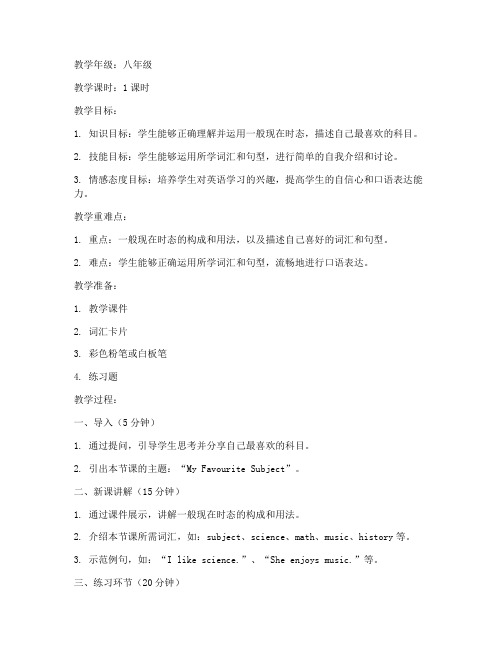
教学年级:八年级教学课时:1课时教学目标:1. 知识目标:学生能够正确理解并运用一般现在时态,描述自己最喜欢的科目。
2. 技能目标:学生能够运用所学词汇和句型,进行简单的自我介绍和讨论。
3. 情感态度目标:培养学生对英语学习的兴趣,提高学生的自信心和口语表达能力。
教学重难点:1. 重点:一般现在时态的构成和用法,以及描述自己喜好的词汇和句型。
2. 难点:学生能够正确运用所学词汇和句型,流畅地进行口语表达。
教学准备:1. 教学课件2. 词汇卡片3. 彩色粉笔或白板笔4. 练习题教学过程:一、导入(5分钟)1. 通过提问,引导学生思考并分享自己最喜欢的科目。
2. 引出本节课的主题:“My Favourite Subject”。
二、新课讲解(15分钟)1. 通过课件展示,讲解一般现在时态的构成和用法。
2. 介绍本节课所需词汇,如:subject、science、math、music、history等。
3. 示范例句,如:“I like science.”、“She enjoys music.”等。
三、练习环节(20分钟)1. 学生通过小组合作,用所学词汇和句型进行自我介绍,描述自己最喜欢的科目。
2. 教师巡视指导,纠正学生的发音和语法错误。
3. 进行小组竞赛,看哪个小组的自我介绍最生动、有趣。
四、巩固环节(10分钟)1. 学生完成练习题,巩固所学知识。
2. 教师讲解练习题的答案,并对学生的表现进行点评。
五、总结与作业布置(5分钟)1. 总结本节课所学内容,强调一般现在时态的构成和用法。
2. 布置作业:要求学生用所学词汇和句型,写一篇关于自己最喜欢的科目的短文。
教学反思:1. 本节课通过提问、小组合作、竞赛等多种形式,激发了学生的学习兴趣,提高了学生的口语表达能力。
2. 在教学过程中,注重纠正学生的发音和语法错误,帮助学生养成良好的英语学习习惯。
3. 课后及时批改作业,关注学生的学习情况,为下一节课做好准备。
英语教资课程设计题模板
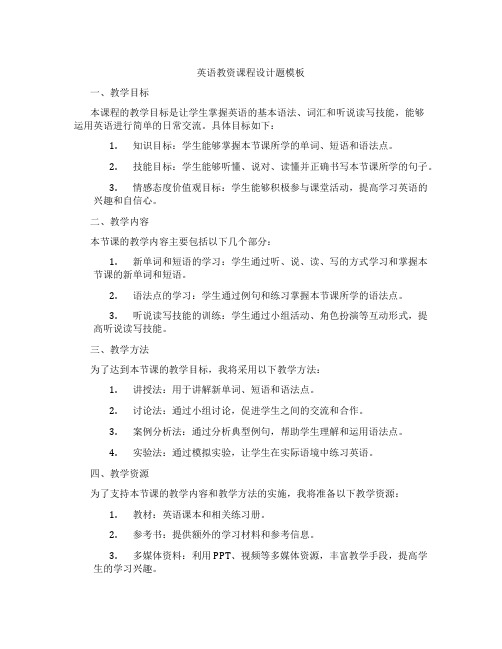
英语教资课程设计题模板一、教学目标本课程的教学目标是让学生掌握英语的基本语法、词汇和听说读写技能,能够运用英语进行简单的日常交流。
具体目标如下:1.知识目标:学生能够掌握本节课所学的单词、短语和语法点。
2.技能目标:学生能够听懂、说对、读懂并正确书写本节课所学的句子。
3.情感态度价值观目标:学生能够积极参与课堂活动,提高学习英语的兴趣和自信心。
二、教学内容本节课的教学内容主要包括以下几个部分:1.新单词和短语的学习:学生通过听、说、读、写的方式学习和掌握本节课的新单词和短语。
2.语法点的学习:学生通过例句和练习掌握本节课所学的语法点。
3.听说读写技能的训练:学生通过小组活动、角色扮演等互动形式,提高听说读写技能。
三、教学方法为了达到本节课的教学目标,我将采用以下教学方法:1.讲授法:用于讲解新单词、短语和语法点。
2.讨论法:通过小组讨论,促进学生之间的交流和合作。
3.案例分析法:通过分析典型例句,帮助学生理解和运用语法点。
4.实验法:通过模拟实验,让学生在实际语境中练习英语。
四、教学资源为了支持本节课的教学内容和教学方法的实施,我将准备以下教学资源:1.教材:英语课本和相关练习册。
2.参考书:提供额外的学习材料和参考信息。
3.多媒体资料:利用PPT、视频等多媒体资源,丰富教学手段,提高学生的学习兴趣。
4.实验设备:如录音机、投影仪等,用于辅助教学。
以上是本节课的教学设计,希望能够帮助学生更好地学习和掌握英语。
五、教学评估本节课的教学评估主要包括以下几个方面:1.平时表现评估:通过观察学生在课堂上的参与度、发言积极性等,评估学生的学习态度和课堂表现。
2.作业评估:通过检查学生的作业完成情况,评估学生对课堂所学知识的掌握程度。
3.考试评估:通过定期的考试,全面测试学生的单词、语法和听说读写技能掌握情况。
六、教学安排本节课的教学安排如下:1.教学进度:按照教材的章节安排,合理安排每个章节的教学内容和教学时间。
初中英语教资考试教案设计模板

教学评价
评价方式
课堂观察:观察学生的表现, 评估教学效果
测试成绩:通过考试或测验, 了解学生的学习情况
学生反馈:收集学生对教学的 意见和建议,改进教学方法
教师反思:对教学过程进行反 思,总结经验教训
评价标准
教学目标是否明 确
教学内容是否符 合教学大纲要求
教学方法是否得 当,是否能激发 学生的学习兴趣
教学过程
导入环节
复习导入:回顾 已学知识,引导 学生进入新课
情境导入:创设 情境,激发学生 兴趣
故事导入:用有 趣的故事吸引学 生注意力
音乐导入:播放 与主题相关的音 乐,引导学生进 入学习状态
知识讲解
知识点的选择:根据教学目标和学生实际情况选择重点和难点 讲解方式:采用多种教学方法,如讲解、示范、举例等 知识点的呈现:采用图表、图片等形式呈现知识点,帮助学生理解 知识点的巩固:通过练习、作业等方式巩固知识点,加强记忆和应用
教学方法
讲解法:教师通过口头语言向学 生传授知识,指导思考和讨论。
讨论法:组织学生进行小组讨论 或全班讨论,培养学生的思维能 力和表达能力。
添Hale Waihona Puke 标题添加标题添加标题
添加标题
直观法:利用实物、图片、模型 等直观教具辅助教学,有助于学 生更好地理解知识。
练习法:通过课堂练习、作业等 方式,让学生实际操作,加深对 知识的理解和记忆。
培养学生的英语思维能力和 表达能力
能力目标
学生能够掌握本节 课的重点词汇和句 型,并能够在实际 情境中运用。
学生能够通过本节 课的学习,提高阅 读理解能力和写作 能力。
学生能够通过本节 课的学习,培养自 主学习和合作学习 的能力。
- 1、下载文档前请自行甄别文档内容的完整性,平台不提供额外的编辑、内容补充、找答案等附加服务。
- 2、"仅部分预览"的文档,不可在线预览部分如存在完整性等问题,可反馈申请退款(可完整预览的文档不适用该条件!)。
- 3、如文档侵犯您的权益,请联系客服反馈,我们会尽快为您处理(人工客服工作时间:9:00-18:30)。
(1)Knowledge objectives①(all)Students master the key words/ phrases: ...②(all)Students learn the target languages: ...③(阅读/听力)Students read/ listen the passage carefully and get specific information.④(写作)Ss can choose the right structure and right tense to write a composition.(2)Ability objectives①Through doing tasks, students practice and consolidate巩固target languages.②Students improve their listening/speaking/reading/writing abilities and communicative competence.③(阅读)Students read the passage and know clear about ...④(阅读)Students discuss in pairs or in groups and do exercises to understand the text.(3)Emotional objectives①Students improve listening and speaking skills by joining in the tasks.②Students can express( what ... are )accurately.③Students love to share ... with others and build a deeper relationship with ...④Students cultivate the habit of (joining a English group ) to improve their language skills.Teaching Contents:(对话)The dialogue talks about ...(阅读)The class is to read.../ It is a passage about ...(听说/听力)It is a listening and speaking lesson talking about...(口语)This is a speaking lesson whose topic is about “how to...”(语法)This is a grammar lesson about tag questions.(读写)This lesson is about reading and writing ...(写作)It is a guided writing lesson. The topic is ...Teaching Key points:(all)Students master the key words and target languages, and can use then correctly.(阅读)Students read the passage and get specific information from the passage.(听力)Ss listen to the tape and do exercise 2b and 2c.(听说)Communicate with others on the topic.Teaching difficult points:(all)Students freely talk about ... in real communication. ( logically/ smoothly/ correctly )(读写/写作)Ss master the skills of writing a proper passage about ...in right way.Step 1 Lead-in ( 5 minutes)Activity 1: ReviewT: What ... do you learn in school? Can you say it in English?(Justification: Reviewing what ss have learned can help ss get ready for the new lesson. ) Activity 2: Sing a song/ Play a short filmThe teacher guides ss to sing a song .../ plays a short film(Justification: Sing a song/ play a film clip that is closely related to the topic of the lesson can arouse ss’ learning interest.)Activity 3: Free talk(Justification: Through free talk, ss get prepared to listening tasks. / help ss know what they will learn in class. )听力课Step 1 Pre-listening ( 5 minutes )Activity : Free talkT: Good morning! Look at ... So tell me ...(Justification: Free talk will attract ss’ interest and teaching content would be naturally led in.) Step 2 While-listening ( 25 minutes)Activity 1: Listen to the tape and finish exercise 2b./ summarize the main idea of the conversation.Activity 2:Listen again. Make up a dialogue according the content of tape. ( T: Talk about ... ) (Teacher show the tapescript on the PPT. Ss read the conversation and circle the key words and sentences in the conversation. The teacher write these on the blackboard such as “...”) Activity 3: Give a report. ( T: Several groups come to the front to act out your dialogue, and others give some evaluation. )(Justification: Through listening and speaking activities, ss master the language knowledge and improve language skills.)Step 3 Post-listening ( 10 minutes)Activity 1: Discussion. (T: Talk about ...)(Justification: Ss use the language knowledge in real communication, which can associate the knowledge with real life.联系)Activity 2: Make a dialogue.Ss work in groups of four to make up a new dialogue by imitating the conversation, especially by using the key words and sentences in the conversation.Activity 3: Role play.Ss act out their dialogue group by group. When one group is acting, the teacher and other ss act as judges. After the performance, the teacher corrects the common language mistakes. At the end, the whole class select one group who performs the best.(Justification: Ss develop their speaking skills and also apply the key knowledge into practice. )Step 1 Pre-task ( 3 minutes)Activity 1: BrainstormT: Please brainstorm about...(The teacher writes down on the blackboard the key words that ss have mentioned )(Justification: Talking about the topic in a real situation can arouse ss’ interest to communicate. ) Step 2 Task-cycle ( 15 minutes)Activity 1: ListeningSs listen to the tape for three times, take notes and finish exercise in the textbook. (Justification: The listening task is language input activity, which will help ss output more language information in the next activity. )Activity 2: Group discussionSs discuss in groups of four about ..., the teacher walk around and give guidance. Several minutes later, they share their ideas in the class group by group.(Justification: Ss improve their listening and speaking abilities and communicative competence.) Step 3 Language focus ( 2 minutes )The teacher guides ss to notice and conclude the target language they used. Then, the teacher writes them on the blackboard.Activity 1: Write a short passageSs are asked to write a short passage to ...(Justification: This step draw ss’attention to the language patterns, which is good for their accurate use of language. )Step 2 Presentation and practice ( 15 minutes)(Show a picture of ...)Activity 1: Question and AnswerActivity 2: Pair workT: Good job. OK, now ask your partner with the sentence “...?” and answer it by “...”.Then tell your reasons.Begin....T: Time is up. Do you know ...?S:Yes.T: Excellent. Who wants to cat out your dialogue?(Justification: To present the new words with pictures and to practice sentences in pair game are good for students to learn and master the target language.)Step 3 Consolidation巩固( 20 minutes)Activity 1: Listen and DiscussT: Now, listen to the tape and find out ...(gist).The tape will be played for three times.At the first time you should summarize the main idea. At the second time, you should listen carefully and circle (new words) that you heard on the blackboard.At third time check your answer.OK?T: Do you understand what the material(材料)is about? Discuss with your partner and find out the right answer.OK?(Then check the answers with whole class.)Activity 2: Make a dialogue/ Pair workT:Make a short conversation by imitating the listening material in pairs.(Five minutes later, the teacher encourages some ss to act out their dialogue.)(Justification: In this step, the purpose is to train ss’ listening and speaking skills. )Step 2 Pre-reading ( 5 minutes)Then ss are encouraged to talk about ... in group of four. Then the teacher asks some volunteers to give a report.(Justification: Through talking about ... , ss perceive感知the language used to ... )Step 3 While-reading ( 15 minutes)Activity 1: Fast readingSs are given one minute to read the short passage quickly, and then conclude the main idea.Activity 2: Careful readingSs are given 5 minutes to read the passage again, then do two exercise:(1)Answer the following questions in order to grasp the detailed information of the passage.①②answer: ①②(2)Read the passage and complete the sentences.①②answer:①②(Justification: The two activities will help ss understand the passage and also train their reading skills.)Step 4 Post-reading ( 15 minutes)Ss write a short passage about ...by imitating the given passage. Then they peer edit each other’s writing and give reasonable suggestions. Students revise their writing and hand in the final draft. (Justification: Ss apply the knowledge they just learned into practice.)Step 2 Presentation ( 5 minutes )The teacher shows the dialogue on the PPT, and asks ss to read the conversation. The teacher instructs them to conclude the usage of ...(Justification: Learning the grammar in inductive way can arouse ss’ learning interest and deepen their understanding of the grammar.)Step 3 Practice ( 8 minutes )Activity 1: Fill in the blanksThe teacher writes down some sentences of ... on the blackboard and asks ss to fill in the blanks with the guidance of the rule they conclude.①②③Answer:①②③After ss finish the exercise, the teacher checks their answer, leads ss to summarize the rule of target language with ss.Activity 2: True or falseThe teacher presents the sentences on the PPT and asks ss to judge which is true and which is false. Such as:①②③Answer:①②③(Justification: The two exercise can check and consolidate ss’ mastery of the grammar. )读写课Step 2 Pre-writing ( 5 minutes )The teacher guides ss to read the passage for two times and find out (the key words and target languages).(Justification: Reading the passage can make ss have a clear understanding of the structure and contents.)Step 3 While-writing ( 20 minutes )Firstly, the teacher shows the format格式and the writing standards标准of ... And then ss should write a first draft by imitating the passage.Secondly, the teacher lets ss revise 修改their letter, especially the spelling and grammar mistakes. At the same time, the teacher walks around the classroom to give them guidance. (Justification: Showing the format and writing standards can help ss polish their own passage. The activity of revising can improve their thinking and writing ability.)Step 4 Post-writing ( 10 minutes )The teacher corrects some common mistakes and makes a comment on the writing (Justification: This step can help ss master some useful writing skills.)Step 1 Pre-writing ( 5 minutes )Activity 1: BrainstormingThe teacher show some photos of ..., and asks ss ... The teacher lists down ss’ideas on the blackboard.(Justification: Brainstorming can activate ss’ thinking, enlarge ss’ language output, and help ss get prepared to write a composition. )Step 2 While-writing ( 10 minutes )Ss are given 5 minutes to write their first draft. When ss are writing, the teacher should walk around the classroom and give them guidance.Activity 1: pair workSs work in pairs to discuss and edit each other’s competition for about 3 minutes. Then ss repolish the second draft.Step 3 Post-writing ( 5 minutes )The teacher corrects the common mistakes and leads the whole class to conclude得出结论the writing essentials必要因素. Ss are asked to hand in their final draft. After the teacher reads over all the composition, he will choose three best ones to exhibit in the class.(Justification: In this step, ss get more information about how to write a better competition. )Step N Summary and homework ( 5 minutes)Students summarize the important points of the lesson, and the teacher gives a further conclusion with the blackboard design.Homework:①Review the words and sentences learned in this class.②实践类作业Make a survey:ask your friends: ——...? And the reasons. (Justification: Extend the classroom knowledge to ss’real life. It is good for ss to apply the knowledge into practice.)③Write a short passage to record what they have learned in the class.(Justification: The summary and homework will help ss review what they have learned in this class.)④Ss rewrite a passage on the topic and hand in the final draft.Board Plan:Words Sentencealoud,pronunciation What about...? Have you...?。
